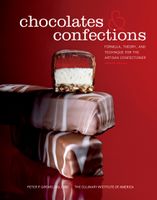Advertisement
Flavoring hard candy
Appears in
By Peter Greweling and Culinary Institute of America
Published 2007
The flavoring used to make hard candy must be extremely concentrated in order for it to flavor the candy without adding too much moisture. For this reason, fruit purées and juices cannot be used. Extracts, oils, and manufactured flavors can all be used successfully in hard-candy production. Because they are usually not heat stable and will dissipate or be significantly altered if they are exposed to the high temperatures of cooking, these flavorings are added after the cooking process is complete, once the mass of syrup has begun to cool. Manufacturers of flavorings stipulate the recommended amount to be used, usually stated as a percentage of the finished batch. Due to their potency, flavorings must be measured and handled with care to ensure consistent results. When a fruit flavoring is used in candies, it is usually accompanied by the addition of a dry acid to provide some of the tart flavor notes found in fruit. The acids most commonly used are citric, malic, and tartaric acids. These should be added only after the sugar has begun to cool on the marble so as not to cause excessive inversion, which would result in undue stickiness and hygroscopicity.



